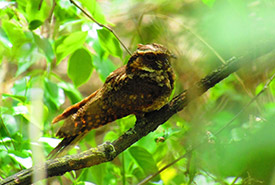Citizen observation at work in the Greater Bristol Marsh

Eastern whip-poor-will (Photo by Tanner Senti)
A haven of biodiversity in the Ottawa Valley, the Greater Bristol Marsh is home to several bird species that are rare or at-risk in Quebec. Recently, about 10 volunteers joined the Nature Conservancy of Canada (NCC) team to inventory and monitor these species. One of the species, the eastern whip-poor-will, is designated threatened in Canada and likely to be designated threatened or vulnerable in Quebec.
At a time when many animals and plants are threatened by habitat destruction, climate change and pollution, it is important to have a good understanding of their situation, as this makes it possible to intervene more effectively to protect them. This knowledge makes it possible to implement measures such as federal and provincial designations, which land use planners must take into account.
For this reason, volunteers gathered at the Greater Bristol Marsh. Accompanied by birding guides from the Club des ornithologues de l'Outaouais, an NCC partner, they toured the listening stations in this area, sites identified as being frequented by rare and at-risk bird species.
Night-time observation
A first group, composed of eight volunteers and two NCC employees, explored the Greater Bristol Marsh at dusk, paying particular attention to the presence of eastern whip-poor-will. Since this bird is only active after sunset, its population must be inventoried at night. The team gathered on a full moon evening, a time when the whip-poor-will is even more likely to make its distinctive song heard, and putting luck on their side as much as possible.
In this instance, nature did not disappoint and, with the teeming environment as a backdrop, put on one beautiful show after another. As night fell, participants were able to see bats fluttering near the tops of the trees. The group also made out, through the choirs of tree frogs, the presence of Wilson's snipe, American bittern, common loon, swamp sparrow and black-crowned night-heron.
The main objective of the evening was achieved: the team was able to hear and even see eastern whip-poor-wills during the evening, two of which were in the midst of hunting. Thanks to the presence of Daniel St-Hilaire, a birding guide, as well as another experienced volunteer, the subtle cry of a common nighthawk was also detected.
Finally, the participants' attention was drawn to the passing of a shooting star. It was a perfect opportunity to wish for great strides in conservation!
A birding morning
In a second phase, another team, also made up of eight volunteers, including Daniel, along with two NCC employees, visited eight listening stations in the morning. The activity was very productive; the group was able to detect the presence of dozens of bird species.
In addition to a large number of Canada geese, red-winged blackbirds, blue jays, American robins and red-eyed vireos, they had the opportunity to detect less common species, such as Virginia rail, pied-billed grebe and sora. The team also heard a great blue heron nesting in the heights of a swamp.
We need you!
NCC thanks the members of the public who helped conduct these inventories; your contribution to conservation actions is invaluable. At the end of these two activities, a participant's guide was given to those who were interested. The guide covers the targeted species and presents the standardized inventory protocol recommended by the Atlas des oiseaux nicheurs du Québec (Atlas of breeding birds of Quebec). Those who wish to do so will be able to continue their observations on this NCC property.
Are you interested in getting involved with NCC? Visit conservationvolunteers.ca for a schedule of upcoming events!
Ensemble pour la nature project
NCC was also able to count on the collaboration of Quebec's ministère de l’Environnement et de la Lutte contre les changements climatiques (MELCC) through the Ensemble pour la nature project. The Ensemble pour la nature project is a three-year, $15-million grant to NCC from MELCC. It aims to establish financial partnerships and acquire scientific knowledge to ensure the conservation and protection of natural environments on private lands in Quebec between now and March 31, 2020. It thus promotes solidarity with respect to protected areas by involving Quebec communities in conservation actions.




